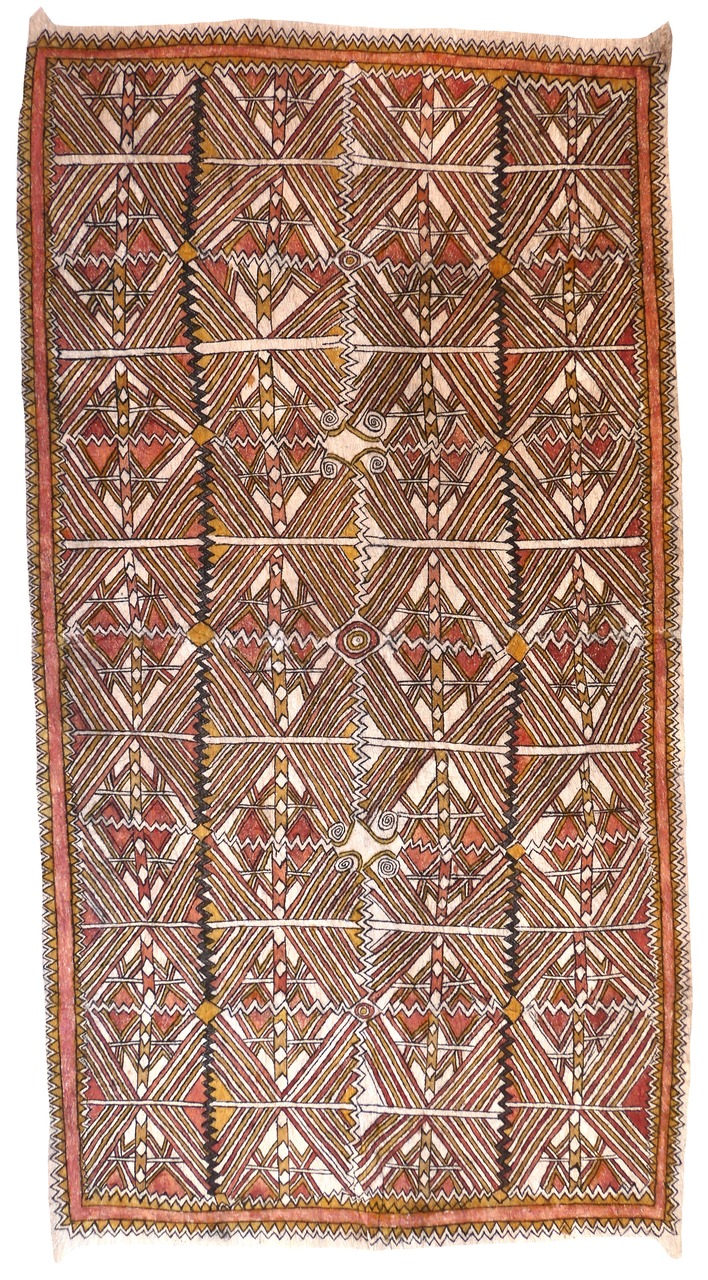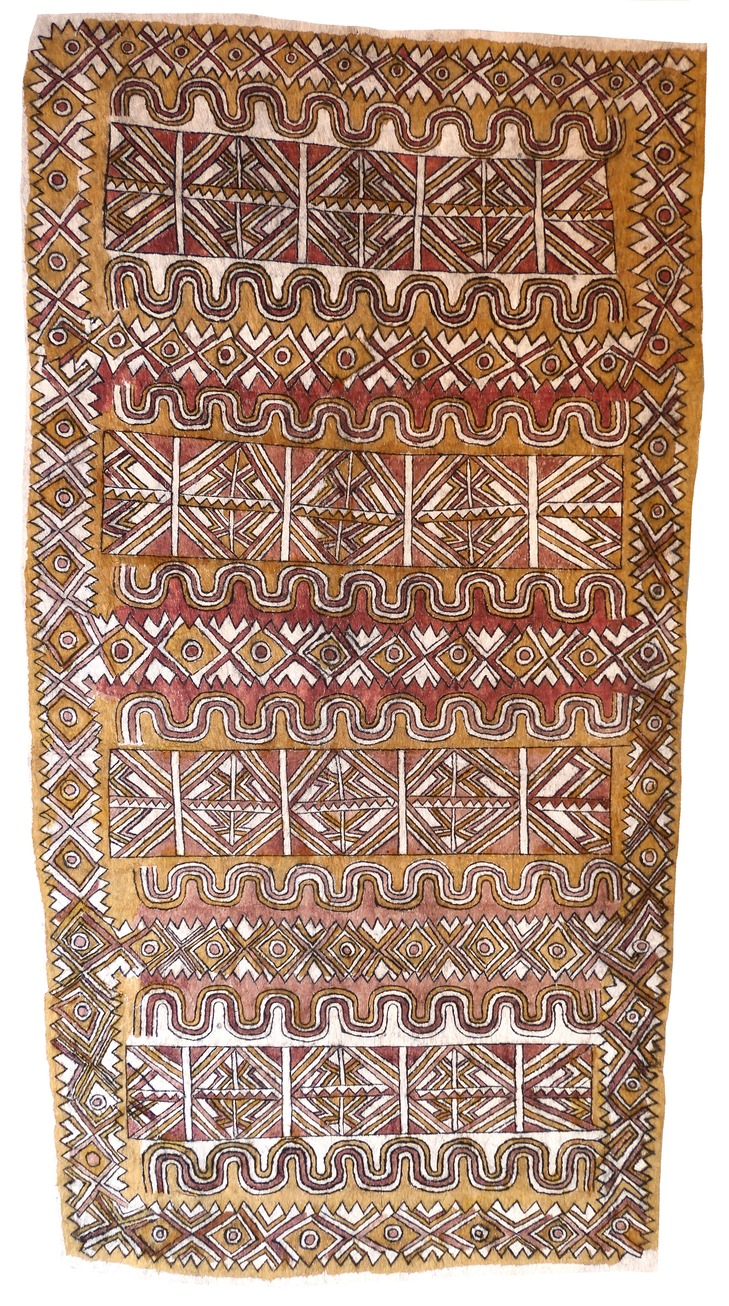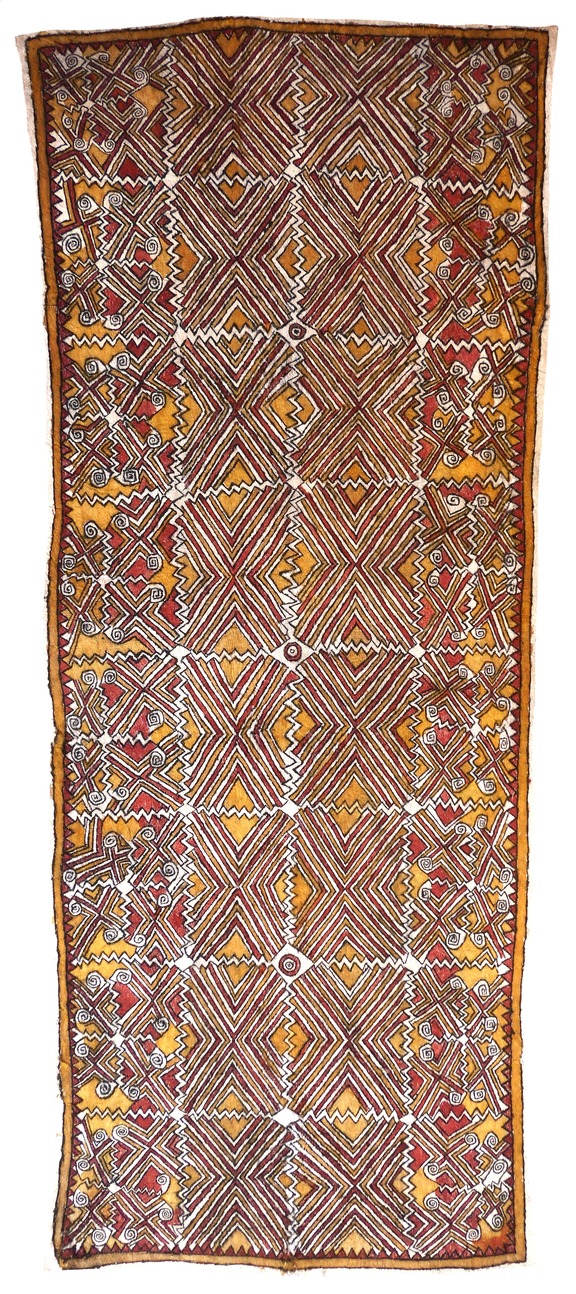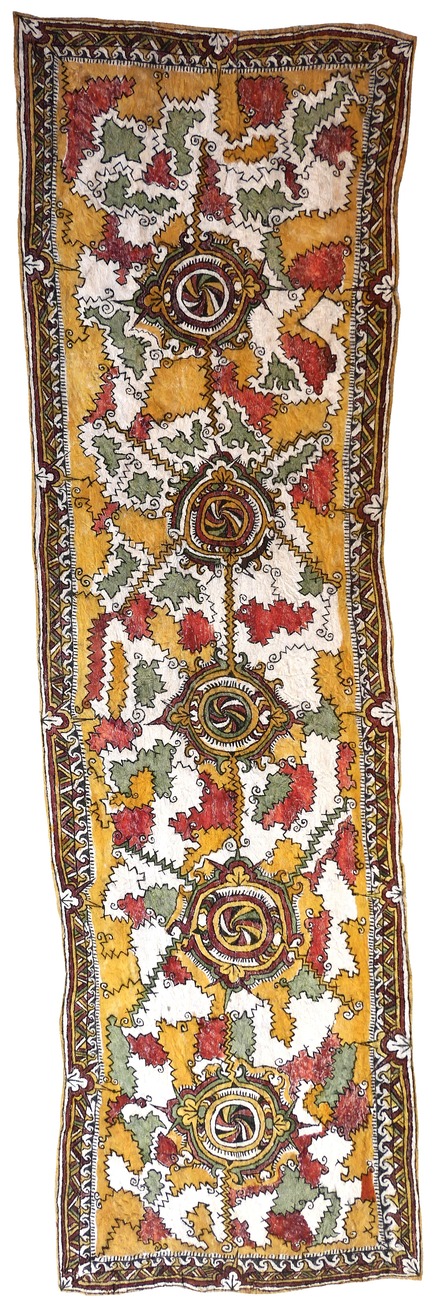Ömie Artists
Ömie Artists Inc. is a cooperative of Ömie women barkcloth painters from Oro Province in south eastern Papua New Guinea. Barkcloth is the traditional textile of the Ömie tribe. Women wear nioge (skirts) while men wear givai (loincloths). Barkcloth serves important purposes in marriage, funerary and initiation ceremonies as well as being an integral part of everyday life. Ömie barkcloths are still worn today by men, women and children during traditional ceremonies which can involve feasting and spectacular performances of singing, dancing and kundu-drumming. Barkcloth is so important to the Ömie that one of the key events in their creation story details how the first woman, Suja, beat the first barkcloth. Nioge have been produced by Ömie women for gallery exhibitions since the cooperative was founded in 2004.
Women prepare the barkcloth by harvesting the inner layer of bark (the phloem) of rainforest trees which they rinse and dry and then fold and pound repetitiously on flat stones until a strong, fibrous sheet of cloth is produced. The cloth is then left to cure in the sun. Red, yellow, green and black natural pigments are created from fruits, ferns, leaves and charcoal. Ancient clan designs are painted in freehand onto the cloth or the cloth is dyed in river mud and the designs are appliquéd. Common painting implements include strong grasses, fashioned wooden sticks and frayed betelnut husks.
Artists inherit clan designs as young women by birthright or marriage from their mothers, grandmothers and mother-in-laws, and in some instances from their fathers and husbands. Most designs are generations old but some elderly artists, usually Chiefs, are free to paint their uehorëro (wisdom), creating new designs. The Ömie’s female Chief system is primarily based upon a woman’s barkcloth painting talents and the cultural knowledge she attains over a lifetime. All painting designs originate or are derived from traditional Ömie culture and the natural environment, maintaining and communicating artists’ deep connection to their ancestors and country. Ömie territory’s lush rainforests, wild rivers, fauna, elemental phenomena and sacred creation sites such as the volcano Huvaimo and Mount Obo provide a plethora of subjects from which artists continue to draw inspiration for their painting designs. Certain designs serve the important purpose of upholding jagor’e, customary Ömie law, passing on essential knowledge such as taboos and educating the next generation about how to protect and preserve sacred sites.
In 1951 Huvaimo erupted which correlated with the coming of the first missionaries who banned the ancient initiation rite known as the ujawé that involved tattooing clan insignia (sor’e) onto the skin. The Dahorurajé clan Chiefs Warrimou and Nogi believed the eruption was a warning from their ancestors’ spirits that reside on Huvaimo – a warning that the old ways were being lost and that they must turn away from the outsiders and hold onto their traditional culture. In order to appease the ancestors, the Chiefs spread the word throughout the tribe, encouraging the women to paint both men and women’s tattoo designs onto the barkcloth. And so triumphantly, the Ömie have managed to preserve their tattoo designs through the women’s strong barkcloth painting tradition.
Ömie Artists is fully owned and governed by Ömie people. Five Art Centres service artists across twelve villages and each of the centres play a vital role by ensuring that the ancient tradition of barkcloth painting as well as traditional culture remain strong and by providing economic returns to their artists. Income generated from sales allows artists and their families access to essential services such as hospitals and secondary schools, and necessities such as medicine, clothes and tools for building houses, hunting and subsistence farming that are otherwise unavailable to them in their remote homelands. Ömie Artists’ Manager works closely with a Committee of Art Centre Coordinators to facilitate sustainable production and ethical sales of artists’ works and to protect the rights of the artists. The Manager and Committee also work in close consultation with Chiefs and elders to ensure that traditional clan copyright laws are upheld and cultural information is verified before distribution. Barkcloth artworks are catalogued and then exhibited internationally in art galleries where, upon sale, a Certificate of Authenticity which provides detailed information about the artwork designs and/or story, and an Artist Biography accompanies each work.
Since the first exhibition in 2006 the barkcloth art of the Ömie women has been highly celebrated, culminating in the National Gallery of Victoria’s landmark exhibition Wisdom of the Mountain: Art of the Ömie in 2009. Artists have also been included in major exhibitions internationally such as 17th Biennale of Sydney at the Museum of Contemporary Art in 2010; Paperskin: The Art of Tapa Cloth at the Museum of New Zealand Te Papa Tongarewa in 2010; Second Skins: Painted Barkcloth from New Guinea and Central Africa at the Fowler Museum at UCLA in 2012; Under the Volcano: Art of Ömie from Papua New Guinea, Museum Fünf Kontinente, Munich, Germany in 2015; and Ömie Barkcloth: Pathways of Nioge, Chau Chak Wing Museum, Sydney, Australia in 2023. Significant collections of Ömie art are held in major public and private collections.
Copyright for the text remains with Ömie Artists Inc.
Artworks
Artist Profile/s
Jean Niduvé (Urihö)
Jean is the daughter of Albert Sirimi (Nanati), the assistant paramount Chief of Ömie men. She is married to Marumo Niduvé. Ematé clan elder Brenda Kesi (Ariré) remembered seeing Jean’s mother-in-law painting barkcloth clan designs, and taught Jean to paint them in 2012. Over the past decade, 2012-2022, Jean has developed into an artist of exceptional painting skill and talent. The emergence and survival of her strong ancestral barkcloth painting designs is quite miraculous for the present day.
Copyright for the text remains with Ömie Artists Inc.
Helen Rubuno
“I went to school but my Ömie teacher has always been my mother. She told me the stories of our history, taught me our songs and how to make gardens. Sometimes while we talked and sang she would paint our history.”
Helen is married to Morris Murray Rubuno. They, along with their five children, are members of the Ina’e clan. Helen began painting nioge (barkcloth) designs such as odunaige - thorned climbing vine; subudejö’e – caterpillar markings (design of the caterpillar’s black spots); jö’e soru’e – patterns of a woman’s facial tattoos. Her work has since evolved and she now paints a very beautiful, spirited design of dahoru’e, the Ömie mountains.
Copyright for the text remains with Ömie Artists Inc.
Wilma Rubuno (Lamay)
As a young girl, Wilma was adopted by the late Cecilia Badaru, a Sahuoté clanwoman. Cecilia was the daughter-in-law of a very important barkcloth painter, Avarro, who was a former Chief of Sahuoté clanwomen. In 2010 Wilma’s mother Cecilia came to her in a dream, she was holding up a barkcloth painting and she asked Wilma “Can you see this design?”...Wilma replied, “Yes” and then her mother told her, “This is your design now and you must paint this design”. The next day when Wilma awoke she began painting the design. When the village Chiefs and elders saw the design Wilma was painting they were very surprised because she was painting one of Avarro’s designs, that is, without ever having met Avarro. Wilma has been very passionate about painting this important barkcloth design. Her painting style has developed to such intricacy, with a truly breathtaking delicate and careful complexity and harmonious balance of designs, that her works dazzle the eye. She is the proud mother of six children.
Copyright for the text remains with Ömie Artists Inc.
Jessie Bujava (Kipora)
Jessie’s father is the Assistant Paramount Chief of Ömie men, Albert Sirimi (Nanati), and her mother was Agnes Sirimi, both Sahuoté clanspeople from Gorabuna village. Jessie was taught to paint traditional Sahuoté clan designs by both her mother Agnes and her grandmother. Along with Ömie artists Lillias Bujava (Kausara) and Barbara Rauno (Inasu), Jessie is part of a new and exciting school of Sahuoté clan painters whose designs are characterized by an excess of orriseegé or ‘pathways’. Orriseegé is most often used to provide a compositional framework for Ömie painting designs and it reaches its extreme limit in Jessie’s works where her traditional symbolic designs conform to a tight, yet organic, geometric format. She often paints siha’e, the design of the fruit of the tree and visuanö’e, the design of the teeth of the mountain fish.
Copyright for the text remains with Ömie Artists Inc.
Barbara Rauno (Inasu)
Barbara’s father is Albert Sirimi (Nanati), a Sahuoté clanman from Gorabuna village and assistant to his brother, the Paramount Chief of Ömie men, Willington Uruhé. Barbara’s grandmother was Avarro, the former Sahuoté clan chief who is still remembered today as a very important barkcloth painter. Albert remembers Avarro’s designs and has been teaching his daughter Barbara so that the Sahuoté clan tradition of barkcloth painting will live on long into the future. Barbara and her husband Douglas are the happy parents of seven children.
Copyright for the text remains with Ömie Artists Inc.
Hilda Mekio
Hilda’s birth mother is Fate Savari (Isawdi), Chief of Dahorurajé clan women. Her mother-in-law is Flora Mekio. She is married to Edgar Mekio and is learning old Ematé clan barkcloth designs that her mother-in-law painted as well as from her mother Fate Savari.
Copyright for the text remains with Ömie Artists Inc.
Diona Jonevari (Suwarari)
Diona Jonevari’s mother was Delma Iarin of Gora village and her father was Abaho Gugonaymi of old Godibehi village (Ematé clan). When Diona married her husband, Nathaniel Jonevari, in 2002, she began to learn to paint the traditional Ömie designs of his mother Dapeni Jonevari (Mokokari), who was the Chief of Ematé clan women and a highly respected artist. Under Dapeni’s tutelage, Diona has become a respected artist in her own right. She incorporates sor’e (tattoo designs) and kuku hon’e sor’e (bamboo smoking pipe designs) taught to her by other elders of her clan such as her father-in-law, Emmanuel Jonevari (c.1920-2010), and Nathan Gama, Chief of Ematé clan men. With this strong foundation and as an astute student, Diona now draws from a wealth of traditional Ömie designs which she paints in her own innovative and expressive style. Her wealth of knowledge, extraordinary natural talent and skills, combined with her bold experimentation, firmly place her among the most significant Ömie artists and she is now leading a new generation of artists.
Copyright for the text remains with Ömie Artists Inc.
Elvina Naumo (Ebahino)
Elvina is the daughter of Mary Naumo, the former Chief of Ematé clan women who was also a highly respected barkcloth artist. She was taught to paint some special designs from her mother before she passed away. She has become an artist of exceptional talent in recent years, painting her dynamic designs in ever experimental and progressive compositions.
Copyright for the text remains with Ömie Artists Inc.
Roseal Rubuno
Roseal Rubuno is a new painter from Birrojo village. She paints with a delicate, minimilist approach that sets her apart from other emerging painters of her generation. Her sense of space and composition is impressive for a young painter and she shows great promise as an important nioge (barkcloth) painter for the Sahuote clan of the southern-most region of the Ömie mountains.
Copyright for the text remains with Ömie Artists Inc.
Lila Warrimou (Misaso)
Lila has been painting for Ömie Artists since its establishment in 2004. As the Paramount Chief of Ömie women her uehore (wisdom) is unrivalled. Her mother was Eronay Atai and her father was Warrimou Moiwa, both Dahorurajé clanspeople from Savodobehi village. She was formerly married to Fabian Jerrirumu to whom she had four children but after he passed away she remarried Nathan Gama, duvahe (Chief) of Ematé clan men. Lila’s auntie Joyce-Bella Mujorumo, former duvahe of Dahorurajé clan women, taught her to paint a plethora of Ömie designs and clan symbols and also taught her about the origins of Ömie art, culture and history. In turn, Lila has taught a number of Ömie women to paint including her sister-in-law Jean-Mary Warrimou (Hujama).
Her work is held in the permanent collections of the National Gallery of Victoria, Melbourne; the Museum of Archaeology and Anthropology, University of Cambridge, UK; and the High Commission of Papua New Guinea, Canberra.
Copyright for the text remains with Ömie Artists Inc.
Stella Üpia (Agisé)
Stella began painting for Ömie Artists at its inception in 2004. Her mother was Yévo and her father was John Koré, both Sahuoté clanspeople originally from Budo village. She is married to Randolph Üpia and has two children to her first husband. Stella’s design jawubimu’é, the design of the mountain pine tree, was shown to her by her husband and was originally painted by the barkcloth artist Jona who was still painting at Asapa c.1967. Stella loves to share the traditional Ömie story behind the mountain pine tree design.
Copyright for the text remains with Ömie Artists Inc.
Faith Jina’emi (Iva)
“My mother was Filma Rumono, she was a Chief of the Sahuoté clan. All Ömie people from all clans and villages knew about her paintings, she was a great artist! She taught me how to paint since I was a small girl and now I am painting her wisdom for our clan and people.” ~ Faith Jina’emmi (Iva)
Faith Jina’emi began painting for Ömie Arists in 2012. She learnt to paint as a young woman from her mother Filma Rumono, Chief of Sahuoté clan women. Faith is now a leading elder and cultural authority of the central region of Ömie territory. She paints her ever-increasingly complex and diverse ancestral designs with vitality and integrity. By confidently playing with compositions and combining her plethora of designs, the results are unpredictable and always spectacular. This is one of the true signs of an Ömie master painter. She has reached a level of painting skill that situates her in the highest echelon of senior Ömie painters. Her exquisite work and its recent developments are a very exciting and surprising addition to the unfolding Ömie art movement.
Copyright for the text remains with Ömie Artists Inc.
Ilma Ugiobari (Ajikum’e)
Ilma Savari is the daughter of venerated elder and pre-eminent Ömie artist Sarah Ugibari. In recent years, Sarah (the oldest living Ömie, at approximately ninety-seven years of age), has begun the crucial task of imparting her store of ancient wisdom to daughter Ilma. Among other things, this has involved Sarah teaching Ilma to paint and sew a number of enduring Ömie and Managalasi barkcloth designs. Both mother and daughter began working with Ömie Artists Inc. in 2009. These days, Ilma spends much of her time preparing barkcloths and painting and sewing the many ancestral designs Sarah has handed-down to her. She also enjoys preparing for (and singing and dancing at) tribal celebrations.
At the dawn of time, Managalas and Ömie Ancestors emerged from the underground cave Vavago as a single people. Over time, these first people migrated across the greater Huvaimo region and into Hydrographer’s Range above Managalasi Plateau. Subsequently this group split into separate tribes which both still celebrate ‘Mina and Suja’, a shared ancestral creation story about the first man and woman. They also have many customs and barkcloth designs in common. Ilma creates works originating from both tribes because her mother Sarah was born Managalasi but later married an Ömie man. It was she who brought knowledge of Managalasi culture into the Ömie realm.
Ilma’s painted Ömie designs depict traditional Sidorajé clan tattoo markings, while her painted Managalasi designs originate from Koruwo and Kiara villages high on Hydrographer’s Range. Her appliquéd mud-dyed barkcloth designs, in the form of Chiefs’ prestige barkcloths, are derived from both tribes. Along with abstract paintings and appliquéd mud-dyed barkcloth designs, Ilma also paints important stories relating to sacred sites of Gora and her surrounding homelands. She uses a unique (for Ömie) combination of figuration and symbolism to create these compelling images.
Copyright for the text remains with Ömie Artists Inc.
Magdalene Bujava (Kolahi)
Magdalene is the daughter of Emily Levoré, former wife of Eric Afukasi and current wife of senior Sahuoté cafe clan-man and master song-man, Raphael Bujava. She began painting for Ömie Artists in 2012 (when she was known as Magdalene Afukasi). She paints designs belonging to her father’s clan, Ematé, as well as her husband’s clan, Sahuoté. She is one of the leading Sahuoté clan painters with knowledge and painting skills directly related to the body designs of the ancient and sacred Ujawé tattooing initiation rite.
Copyright for the text remains with Ömie Artists Inc.
Petra Ijaja (Jaujé)
Petra’s mother is Pina Goja and her father is Kinsley Goja, an Ina’e clanman. She is learning to paint old Sahuoté clan designs from the Assistant Paramount Chief of Ömie men, Albert Sirimi. Albert is a highly respected elder and the foremost authority on Sahuoté clan stories and designs, having learnt from his mother, Avarro. Avarro is still remembered today as a master Sahuoté clan painter and has left a vast legacy of designs to her living descendants like Petra.
Copyright for the text remains with Ömie Artists Inc.
























